Research on Dynamic Analysis and Mitigation Strategies of Supply Chains under Different Disruption Risks
Abstract
1. Introduction
2. Literature Review
2.1. Dynamic Research and Analysis of Supply Chain Interruption
2.2. Review of Supply Chain Disruption Management
2.3. System Dynamics Method
2.4. Summary of Research Content
3. Research Design
3.1. Research Hypothesis
- This study examined the supply chain composed of suppliers, manufacturers, and retailers.
- The data in this study related to the inventory size and time setting of Zhengtai enterprises at a certain period of time, which do not change during a short interval.
- The costs of suppliers, manufacturers, and retailers do not change in a short period of time.
- The demand of all supply chain nodes is determined in a certain period of time.
- The topological structure of the supply chain is a network.
- In the supply chain, the upstream enterprise is a leader, and downstream enterprises follow the arrangement of the upstream business.
3.2. Model Building
3.2.1. Determination of Model Purpose, System Boundary, and Hypothesis
3.2.2. Construction of Traditional Supply Chain Management Model
3.2.3. Causal Loop Diagram of Supply Chain Subsystem
- Causal loop diagram of the supplier subsystem
- 2.
- Causal loop diagram of the manufacturer subsystem
- 3.
- Causal loop diagram of retailer subsystem
3.2.4. Feedback Structure Analysis and Variable Setting of Supply Chain System
3.3. Data Sources
3.4. SD Model Construction Process of Traditional Supply Chain
3.5. Scenario Setting
- Scenario 1: when the supply interruption occurs, the delivery rate from the supplier to the manufacturer is 0 for the entire period of weeks 18–27.
- Scenario 2: when the production is interrupted, the manufacturer’s delivery rate to the retailer is 0 for the entire period of weeks 18–27.
- Scenario 3: when the sales interruption occurs, the retailer’s delivery rate is 0 for the entire period of weeks 18–27, and the demand has a fault.
- Scenario 4: during the whole cycle, the interruption does not occur. This situation is taken as a basic scenario. The purpose of our simulation was to compare it with the other three scenarios, highlight the change trend of inventory, order accumulation, and profit level under the disruption scenario, and further explain the loss of the supply chain caused by interruption.
4. Result
4.1. The Changes of Supply Chain Inventory Level
4.2. The Changes of Cumulative Order Rate of Supply Chain
4.3. The Changes of Supply Chain Profit Level
5. Discussion
5.1. Analysis of the Impact of Different Interruption Times on the Operating Status of the Supply Chain
5.2. Supply Chain Disruption Mitigation Strategy
6. Conclusions and Prospect
6.1. Research Conclusion
- (1)
- From the perspective of the impact of different interruptions on the operation status of supply chain node enterprises, the node enterprises closer to the source of interruptions are more vulnerable. It is clear that the interruption spreads to other node enterprises due to the conduction effect of the supply chain system, and the longer the interruption, the stronger the chain effect and the more serious the damage to the supply chain system.
- (2)
- According to the influence degree of different types of interruptions on supply chain members, the results show that the disruption degree of supply interruption on the inventory stability and order accumulation rate of the supply chain operation is far greater than that of the downstream sales interruption. An interruption that occurs downstream has a weak impact on inventory and order accumulation. Supply chain managers should pay attention to the status of upstream nodes, and realize that suppliers are the key to ensuring the normal operation of the supply chain network. Therefore, it is necessary to strengthen the quality management system of the whole process of supply chain procurement, improve the ability to assess raw material delivery and the stability of upstream suppliers, and establish and improve the interruption prevention mechanism from the source.
- (3)
- The occurrence of any disruption will not only affect a single node enterprise. Once the interruption crisis occurs, the interests of the whole supply chain will be damaged, and the level of each benefit index will reach the lowest level. In essence, the design and operation of the supply chain should take full account of this ripple effect.
- (4)
- To better address supply, production, and sales interruptions, enterprises cooperate with other supply chain systems on the basis of the original single chain, and establish four mitigation strategies of the double chain. This study focused on the analysis of inventory coordination among different levels and across chains. This can improve the ability of node members to deal with disruption risk, and improve the response ability and flexibility of the supply chain.
6.2. Future Prospects
- (1)
- Different types of interruption scenarios can be studied. Although the outages at different nodes were considered comprehensively, each outage scenario assumes that only one of the nodes is out of service. In the actual operation process, there may be several different types of interruptions at the same time. In the future, different types of interruption studies may be considered at the same time, and multiple contingency strategies shall be selected for joint implementation to maximize the cost of loss control.
- (2)
- For the setting of the interruption situation, factors such as probability of occurrence, duration, and recovery time can be added to study how these factors affect the interruption situation and the benefit of supply chain system, so as to help the managers of node enterprises have a clearer and more comprehensive understanding of interruption emergency management.
- (3)
- Regarding supply chain disruption, indicators of customer satisfaction, cost, transportation volume, and other perspectives can be considered to measure the impact of disruptions at different locations on the supply chain. The countermeasures to improve the ability of node enterprises were proposed to deal with crises and mitigate the impact of interruptions on the whole supply chain according to different types of interruptions, which helps to supplement and improve the system for supply chain interruptions. It is of great significance to build a flexible supply chain to help node enterprises achieve a rapid response ability and implement repairs following interruptions, and to maintain a stable and sustainable operation ability.
- (4)
- Our current research on disruption was based on the three-level supply chain of suppliers, manufacturers, and sellers. In the future, our research can be extended to a multi-level supply chain, that is, considering the risk of supply chain disruption with more than three nodes. This can better promote the sustainable development of the supply chain by studying the dynamic change law of the supply chain caused by supply, production, and sales interruptions. However, due to the limitations of time and energy, we did not conduct a detailed examination. The sustainable development of the supply chain resulting from these three kinds of interruptions needs further investigation in the future.
Author Contributions
Funding
Institutional Review Board Statement
Informed Consent Statement
Data Availability Statement
Conflicts of Interest
References
- Azad, N.; Saharidis, G.K.D.; Davoudpour, H.; Malekly, H.; Yektamaram, S.A. Strategies for protecting supply chain networks against facility and transportation disruptions: An improved Benders decomposition approach. Ann. Oper. Res. 2013, 210, 125–163. [Google Scholar] [CrossRef]
- Hu, H.; Shi, L.; Ma, H.; Ran, B. Stability of the Supply Chain Based on Disruption Classification. Teh. Vjesn. Tech. Gaz. 2017, 24, 1187–1195. [Google Scholar]
- Dillon, R.L.; Mazzola, J.B. Management of disruption risk in global supply chains. IBM J. Res. Dev. 2010, 54. [Google Scholar] [CrossRef]
- Zhao, K.; Zuo, Z.Y.; Blackhurst, J.V. Modelling supply chain adaptation for disruptions: An empirically grounded complex adaptive systems approach. J. Oper. Manag. 2019, 65, 190–212. [Google Scholar] [CrossRef]
- Johnson, N.; Elliott, D.; Drake, P. Exploring the Role of Social Capital in Facilitating Supply Chain Resilience. Supply Chain Manag. Int. J. 2013, 18, 324–336. [Google Scholar] [CrossRef]
- Lucker, F.; Seifert, R.W.; Bicer, I. Roles of inventory and reserve capacity in mitigating supply chain disruption risk. Int. J. Prod. Res. 2019, 57, 1238–1249. [Google Scholar] [CrossRef]
- Wang, H.; Gu, T.; Jin, M.Z. The complexity measurement and evolution analysis of supply chain network under disruption risks. Chaos Solitons Fractal 2018, 116, 72–78. [Google Scholar] [CrossRef]
- Liu, W. An analysis of the impact of the “3.11” earthquake on Japan and the world economy. J. Hubei Second Norm. Univ. 2011, 28, 75–78. [Google Scholar]
- Ren, Z.K. Huawei Global Supply Chain Analysis and Risk Assessment. GuangDong Sci. Technol. 2019, 28, 58–61. [Google Scholar]
- Tan, Y.W.; Li, C.X.; Chen, Z.G. The impact of Xinguan pneumonia on the supply chain of agricultural products in China and ASEAN region and the countermeasures. Agric. Econ. Issues 2020, 10, 113–121. [Google Scholar]
- Shi, X.L. Novel coronavirus pneumonia impact on China’s logistics and global supply chain and Countermeasures. Logist. Res. 2020, 01, 11–16. [Google Scholar]
- Xu, S.; Zhang, X.T.; Feng, L.P.; Yang, W.T. Disruption risks in supply chain management: A literature review based on bibliometric analysis. Int. J. Prod. Res. 2020, 58, 3508–3526. [Google Scholar] [CrossRef]
- He, Y.; Li, S.S.; Xu, H. An In-Depth Analysis of Contingent Sourcing Strategy for Handling Supply Disruptions. IEEE Trans. Eng. Manag. 2020, 67, 201–219. [Google Scholar] [CrossRef]
- Olivares-Aguila, J.; ElMaraghy, W. System dynamics modelling for supply chain disruptions. Int. J. Prod. Res. 2020. [Google Scholar] [CrossRef]
- Abdullah, M.A.; Hishamuddin, H.; Bazin, N. A System Dynamics Approach to Investigate the Effects of Disruption on the Supply Chain with a Mitigation Strategy. Mater. Sci. Eng. 2019, 697, 27–28. [Google Scholar] [CrossRef]
- Mokhtar, S.; Bahri, P.A.; Moayer, S. Supplier portfolio selection based on the monitoring of supply risk indicators. Simul. Model. Pract. Theory 2020, 97. [Google Scholar] [CrossRef]
- Shao, L.G.; Jin, S.Z. Resilience assessment of the lithium supply chain in China under impact of new energy vehicles and supply interruption. J. Clean. Prod. 2020, 252, 119624. [Google Scholar] [CrossRef]
- Jabbarzadeh, A.; Fahimnia, B.; Sheu, J. Designing a supply chain resilient to major disruptions and supply/demand interruptions. Transp. Res. Part B—Methodol. 2020, 94, 121–149. [Google Scholar] [CrossRef]
- Nasr, W.W.; Salameh, M.K.; Moussawi-Haidar, L. Transshipment and safety stock under stochastic supply interruption in a production system. Comput. Ind. Eng. 2012, 63, 274–284. [Google Scholar] [CrossRef]
- Hou, Y.M.; Zhang, Q. The optimal inventory Control of a system with random lead time where random supply interruptions affect the replenishment. ASIA—Pac. J. Oper. Res. 2009, 26, 533–557. [Google Scholar] [CrossRef]
- Neiger, D.; Rotaru, K.; Churilov, L. Supply chain risk identification with value-focused process engineering. J. Oper. Manag. 2009, 27, 154–168. [Google Scholar] [CrossRef]
- Olson, D.L.; Wu, D.D. A review of enterprise risk management in supply chain. Kybernetes 2010, 39, 694–706. [Google Scholar] [CrossRef]
- Shen, G.; Aydin, S.G. Highway freight transportation disruptions under an extreme environmental event: The case of Hurricane Katrina. Int. J. Environ. Sci. Technol. 2014, 11, 2387–2402. [Google Scholar] [CrossRef]
- Samvedi, A.; Jain, V.; Chan, F.T.S. Quantifying risks in a supply chain through integration of fuzzy AHP and fuzzy TOPSIS. Int. J. Prod. Res. 2013, 51, 2433–2442. [Google Scholar] [CrossRef]
- Shareef, M.A.; Dwivedi, Y.K.; Kumar, V. Sustainable supply chain for disaster management: Structural dynamics and disruptive risks. Ann. Oper. Res. 2020. [Google Scholar] [CrossRef]
- Wu, Y.N.; Jia, W.B.; Li, L.W.Y.; Song, Z.; Xu, C.; Liu, F. Risk assessment of electric vehicle supply chain based on fuzzy synthetic evaluation. Energy 2019, 182, 397–411. [Google Scholar] [CrossRef]
- Wang, X.J.; Chan, H.K.; Yee, R.W.Y.; Diaz-Rainey, I. A two-stage fuzzy-AHP model for risk assessment of implementing green initiatives in the fashion supply chain. Int. J. Prod. Econ. 2012, 135, 595–606. [Google Scholar] [CrossRef]
- Lockamy, A. Assessing disaster risks in supply chain. Ind. Manag. Data Syst. 2014, 114, 755–777. [Google Scholar] [CrossRef]
- Ruiz-Torres, A.J.; Mahmoodi, F.; Zeng, A. Supplier selection model with contingency planning for supplier failures. Comput. Ind. Eng. 2013, 66, 374–382. [Google Scholar] [CrossRef]
- Mangla, S.K.; Kumar, P.; Barua, M.K. Risk analysis in green supply chain using fuzzy AHP approach: A case study. Resour. Conserv. Recycl. 2015, 104, 375–390. [Google Scholar] [CrossRef]
- Fakhrzad, M.B.; Goodarzian, F. A fuzzy multi-objective programming approach to develop a green closed-loop supply chain network design problem under uncertainty: Modifications of imperialist competitive algorithm. Rairo-Oper. Res. 2019, 53, 963–990. [Google Scholar] [CrossRef]
- Aqlan, F.; Ali, E.M. Integrating lean principles and fuzzy Bow-Tie analysis for risk assessment in chemical industry. J. Loss Prev. Process Ind. 2014, 29, 39–48. [Google Scholar] [CrossRef]
- Ivanov, D. Simulation–based ripple effect modelling in the supply chain. Int. J. Prod. Res. 2017, 55, 2083–2101. [Google Scholar] [CrossRef]
- Li, X.J.; Ji, J.H.; Da, J.H. Performance analysis of supply chain operation mode based on supply interruption. Chin. J. Manag. Sci. 2012, 20, 541–548. [Google Scholar]
- Paul, S.K.; Rahman, S. A quantitative and simulation model for managing sudden supply delay with fuzzy demand and safety stock. Int. J. Prod. Res. 2018, 56, 4377–4395. [Google Scholar] [CrossRef]
- Forrester, J.W. Industr ial Dynamics; Pegasus Communications Inc.: Waltham, MA, USA, 1961. [Google Scholar]
- Forrester, J.W. Industrial dynamics:a major breakthrough for decision makers. Harv. Bus. Rev. 1958, 36, 37–66. [Google Scholar]
- Sterman, J.D. Modeling managerial behavior: Misperceptions of feedback in a dynamic decision making experiment. Manag. Sci. 1989, 35, 321–339. [Google Scholar] [CrossRef]
- Liu, Q.S.; Jiang, G.Y. Research on bullwhip effect in Supply Chain Based on system dynamics. China Manag. Inf. 2009, 6, 72–75. [Google Scholar]
- Chaerul, M.; Tanaka, M.; Shekdar, A.V. A system dynamics approach for hospital waste management. Waste Manag. 2007, 28, 442–449. [Google Scholar] [CrossRef] [PubMed]
- Ma, S.H.; Lin, Y.; Chen, Z.X. Supply Chain Management; Machine Press: Beijing, China, 2000; pp. 175–183. [Google Scholar]
- Peng, M.; Peng, Y.; Chen, H. Post-seismic supply chain risk management: A system dynamics disruption analysis approach for inventory and logistics planning. Comput. Oper. Res. 2014, 42, 14–24. [Google Scholar] [CrossRef]
- Bashiri, M.; Tjahjono, B.; Lazell, J.; Ferreira, J.; Perdana, T. The Dynamics of Sustainability Risks in the Global Coffee Supply Chain: A Case of Indonesia-UK. Sustainability 2021, 13, 589. [Google Scholar] [CrossRef]
- Tang, H. Structural Analysis and Preventive Strategy of Risks and Influence Factors of Agricultural Produce Supply Chains Based on ISM. Logist. Technol. 2014, 20, 377–382. [Google Scholar]
- Wang, J.; Chen, X. Manufacturer’s Risk Response under Supply Chain Disruption Risk. Ind. Eng. Manag. 2019, 24, 27–34. [Google Scholar]
- Grossler, A.; Thun, J.H.; Milling, P.M. System dynamics as a structural theory in operations management. Prod. Oper. Manag. 2008, 17, 373–384. [Google Scholar] [CrossRef]
- Wang, H.H.; Wu, Z.X. Dynamic simulation of inventory control system based on Vensim. China Manag. Inf. 2014, 17, 44–46. [Google Scholar]
- Chen, Q.Q. Research on Inventory Management Model in Cluster Supply Chains Based on System Dynamics; South China University of Technology: Guangzhou, China, 2013. [Google Scholar]
- Liu, Y.L. Research on Inventory Coordination Mechanism for Dual–Channel Supply Chain; North China Electric Power University: Beijing, China, 2016. [Google Scholar]
- Sterman, J.D. Business Dynamics: Systems Thinking and Modeling for a Complex World; McGraw Hill: New York, NY, USA, 2000. [Google Scholar]
- Kochana, C.G.; Nowicki, D.R.; Sauser, B.; Randall, W.S. Impact of cloud-based information sharing on hospital supply chain performance: A system dynamics framework. Int. J. Prod. Econ. 2018, 195, 168–185. [Google Scholar] [CrossRef]
- Wang, Q.P.; Cai, Y.Y.; Jia, J.G. Review and comment: From system dynamics to organizational learning. Chin. J. Manag. Sci. 2000, S1, 237–247. [Google Scholar]
- Groene, S.; Foerster, S.; Hiete, M. Long-term impact of environmental regulations and eco–conscious customers in the chemical industry: A system dynamics approach to analyze the effect of multiple disruptions. J. Clean. Prod. 2019, 227, 825–834. [Google Scholar] [CrossRef]
- Shao, L.S.; Qin, Z.W. Emergency Strategy for Supply Chain under Supply Node’s Failure. Chin. J. Manag. 2013, 10, 913–918. [Google Scholar]
- Qin, Y.H. Quantity flexibility contract with effect and return price in perishable product’s supply chain. J. Cent. China Norm. Univ. (Nat. Sci. Ed.) 2012, 46, 477–482. [Google Scholar]
- Wang, Y.; Jiang, Y.Y.; Deng, Z.F. Analysis of Logistics Service Supply Chain Risk in Uncertain Environment. Bus. Res. 2011, 411, 179–183. [Google Scholar]
- Wilson, M.C. The impact of transportation disruptions on supply chain performance. Transp. Res. Part E Logist. Transp. Rev. 2007, 43, 295–320. [Google Scholar] [CrossRef]
- Deng, A.M.; Wen, X.P. Analysis of the impact of supply chain disruption on supply chain profit based on system dynamics. Logist. Technol. 2015, 34, 208–211 + 269. [Google Scholar]
- Wen, X.P. Research on the Impact of Supply Chain Disruption on Supply Chain Performance Based on System Dynamics; Hunan University: Changsha, China, 2015. [Google Scholar]
- Qian, H. Research on Supply Chain Inventory Coordination Control under Logistics Disruption; North China Electric Power University: Beijing, China, 2017. [Google Scholar]
- Han, M.L. Supply Chain Disruption Risk Analysis and Coordination Management Research; Donghua University: Shanghai, China, 2008. [Google Scholar]
- Wang, X.J.; Tiwari, P.; Chen, X. Communicating supply chain risks and mitigation strategies: A comprehensive framework. Prod. Plan. Control 2017, 28, 1023–1036. [Google Scholar] [CrossRef]
- Lee, C.W.; Ulferts, G.W. Managing Supply Chain Risks and Risk Mitigation Strategies. North Korean Rev. 2011, 7, 34–44. [Google Scholar] [CrossRef]
- Zhu, S.X. Analysis of dual sourcing strategies under supply disruptions. Int. J. Prod. Econ. 2015, 170, 191–203. [Google Scholar] [CrossRef]
- Bustamante, M.L.; Gaustad, G.; Alonso, E. Comparative Analysis of Supply Risk-Mitigation Strategies for Critical Byproduct Minerals: A Case Study of Tellurium. Environ. Sci. Technol. 2018, 52, 11–21. [Google Scholar] [CrossRef] [PubMed]
- Zeng, N.M.; He, Q. Dual Sourcing Strategy for High-Tech Manufacturer under Supply Risk and Capacity Constraint. IEEE Access 2019, 7, 42672–42682. [Google Scholar] [CrossRef]
- Li, G.; Kang, Y.C.; Liu, M.Q. Dual-source procurement strategies for manufacturers with supply disruption risks. J. Intell. Fuzzy Syst. 2017, 33, 2637–2645. [Google Scholar] [CrossRef]
- Li, X.; Li, Y.J. On the loss-averse dual-sourcing problem under supply disruption. Comput. Oper. Res. 2018, 100, 301–313. [Google Scholar] [CrossRef]
- Khojasteh-Ghamari, Z.; Irohara, T. A multi-criteria double sourcing based optimization approach to manage the supply chain risk. Int. Conf. Ind. Eng. Manag. Sci. Appl. 2017, 126–130. [Google Scholar] [CrossRef]
- Ahmadi-Javid, A.; Hoseinpour, P. Service system design for managing interruption risks: A backup-service risk-mitigation strategy. Eur. J. Oper. Res. 2019, 274, 417–431. [Google Scholar] [CrossRef]
- Zheng, Y.; Zhao, X.L. The Double-Source Purchase Decisions with Substitution under Cap and Trade Policy. Int. Conf. Appl. Math. Simul. Model. 2016, 41, 83–87. [Google Scholar]
- Chiang, D.M.; Guo, R.S.; Pai, F.Y. Retailer’s optimal sourcing strategy by using one major supplier and one emergent supplier. Optim. Lett. 2011, 5, 319–331. [Google Scholar] [CrossRef]

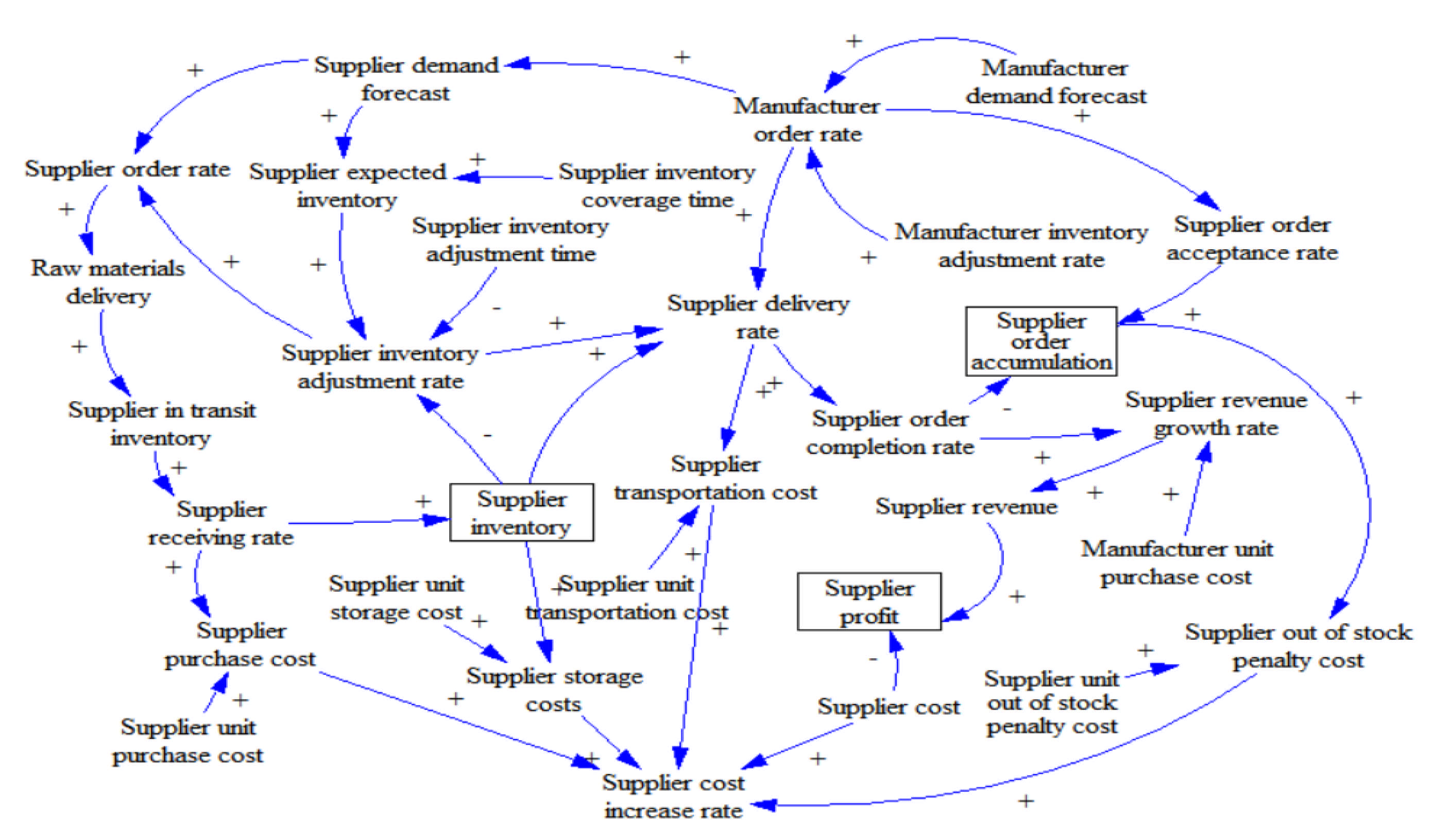

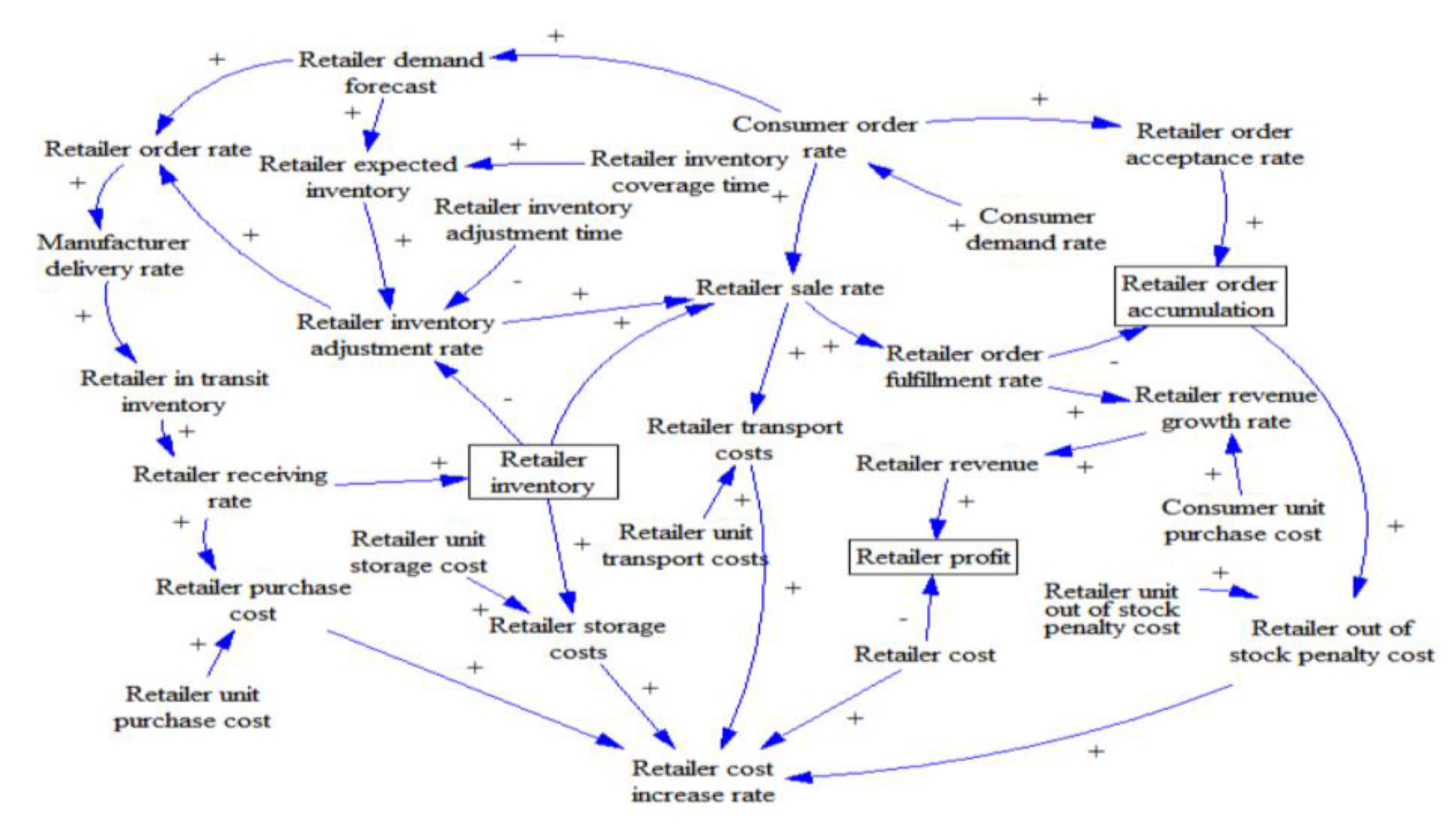

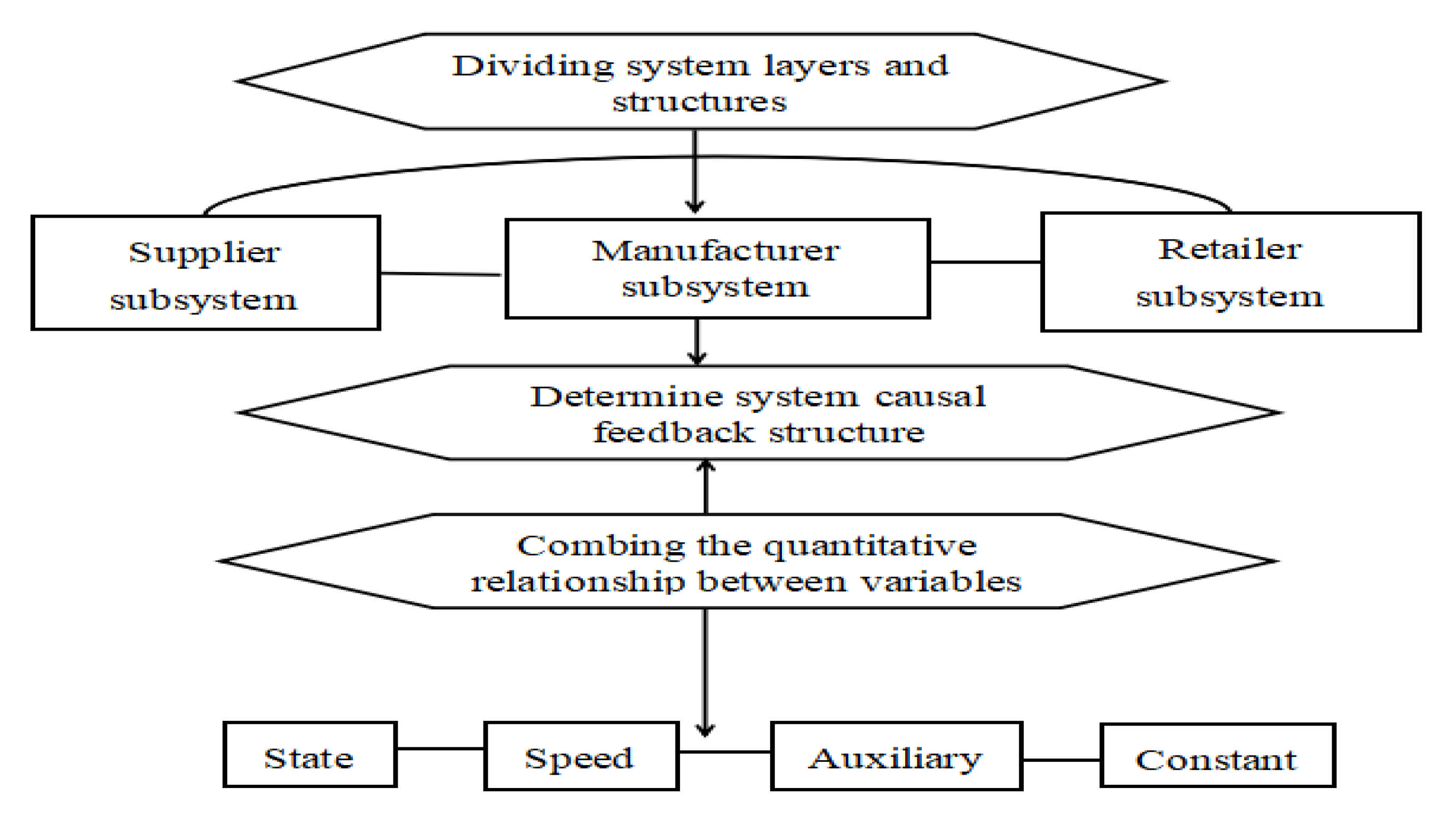

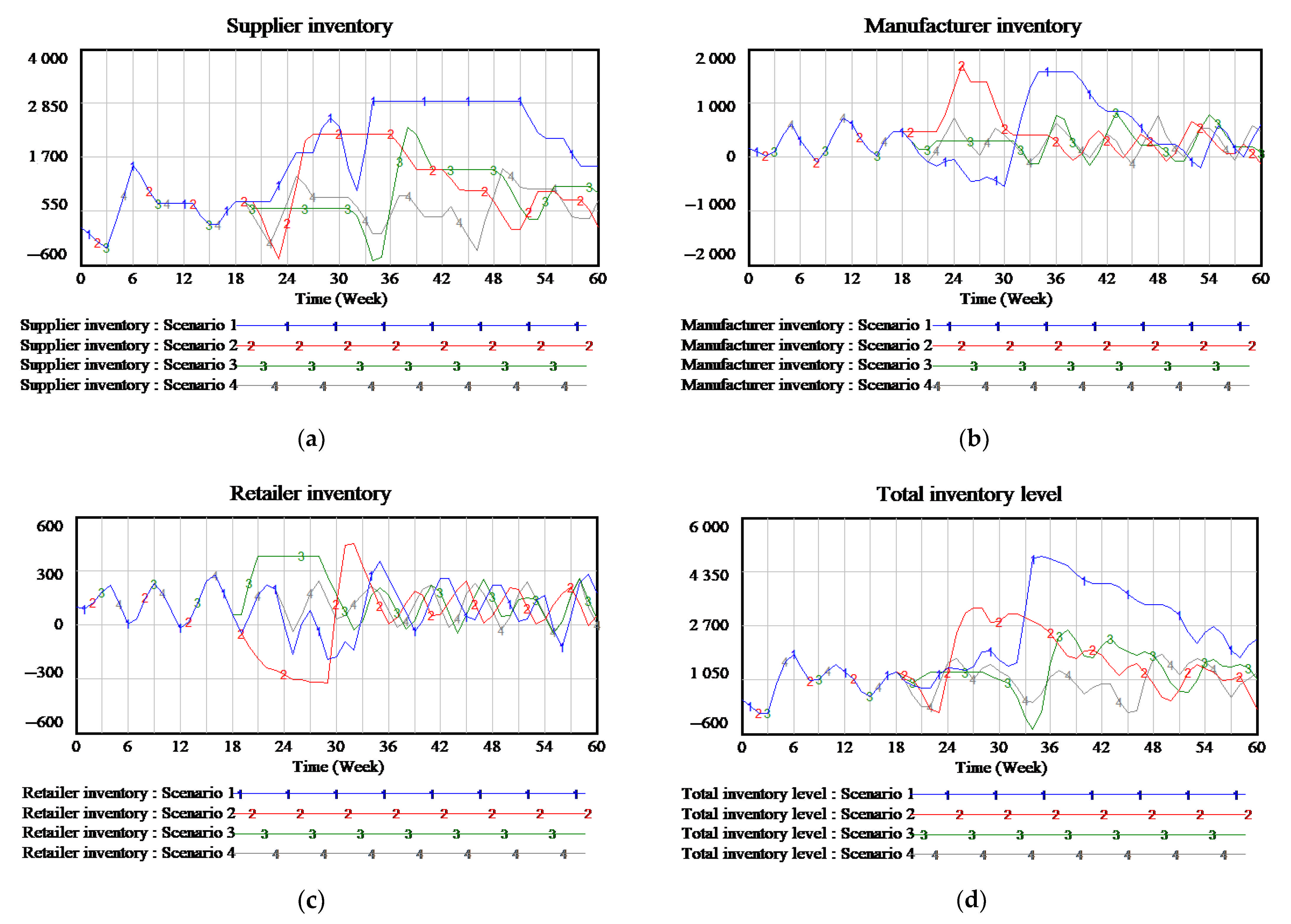

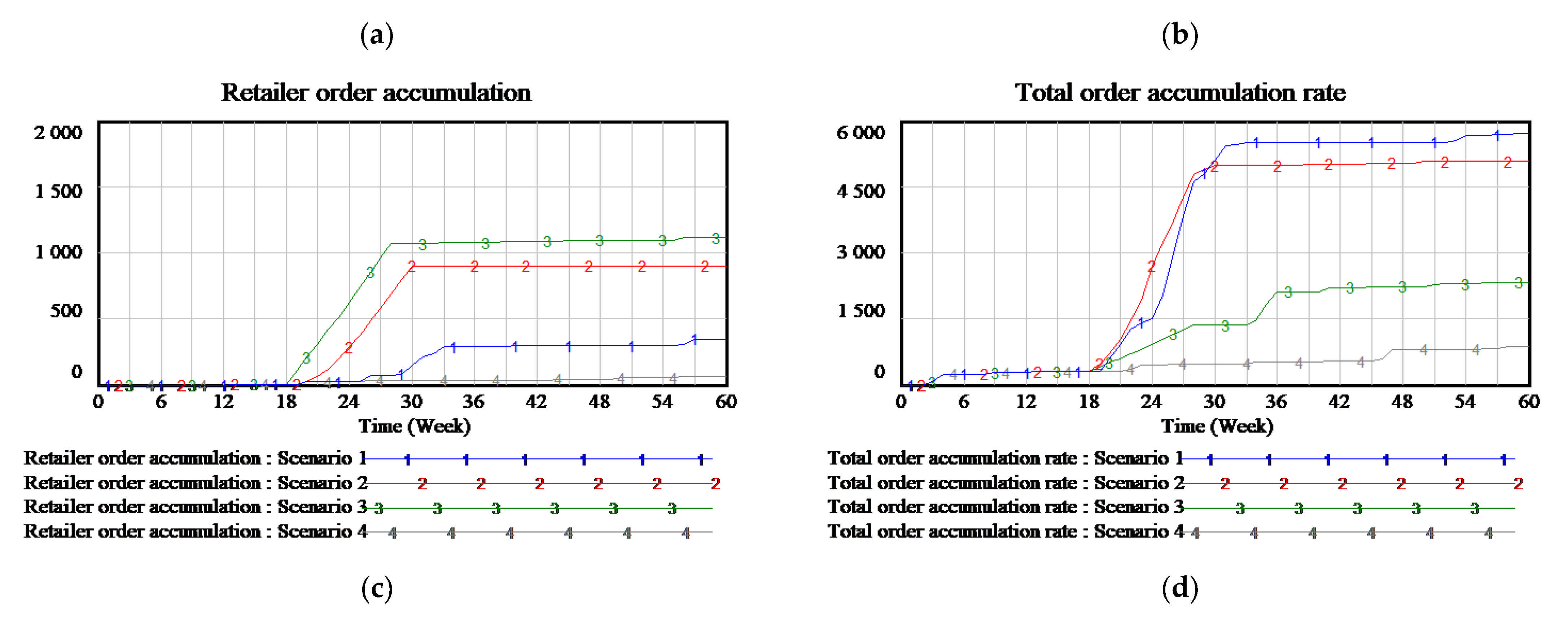

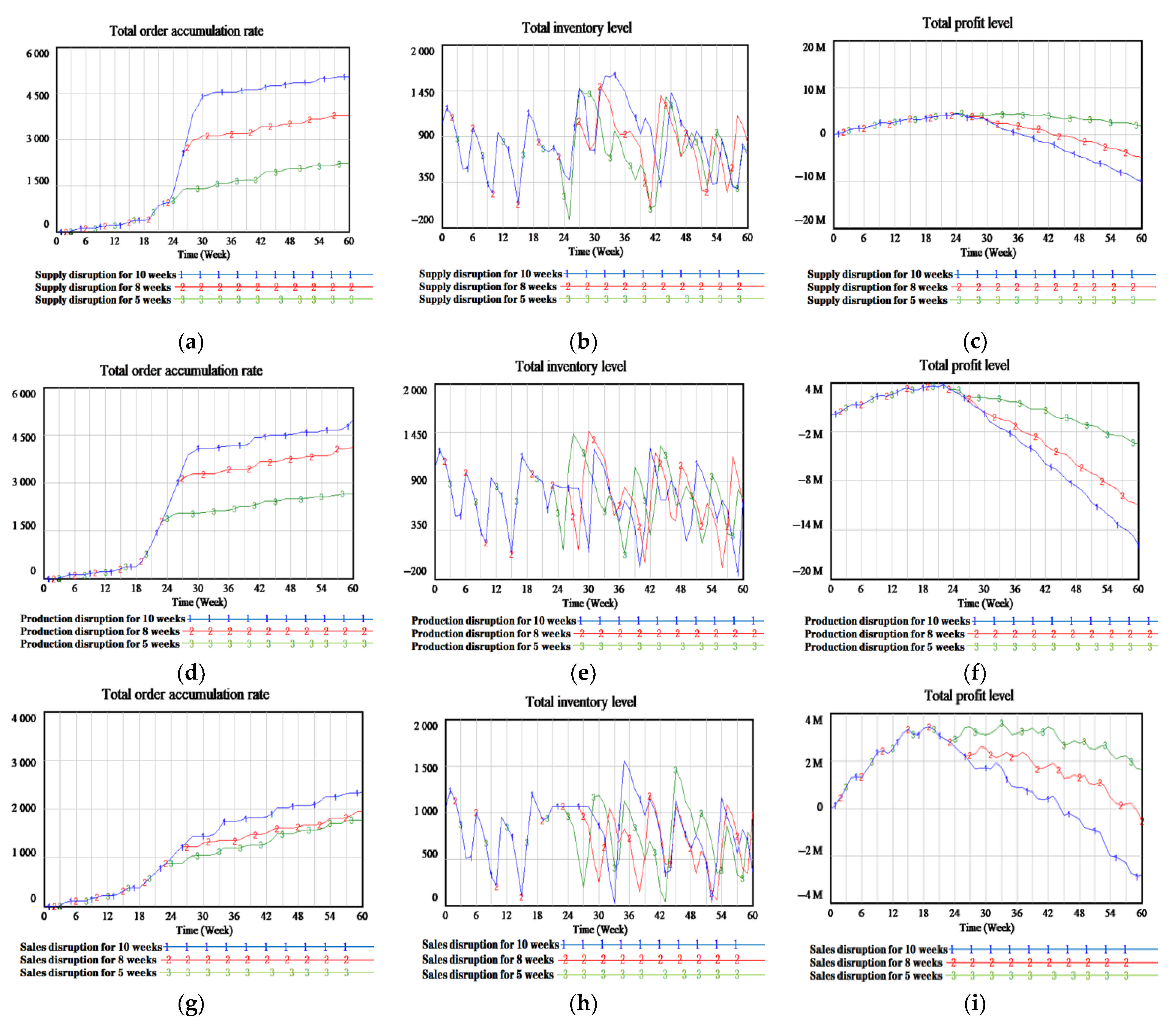
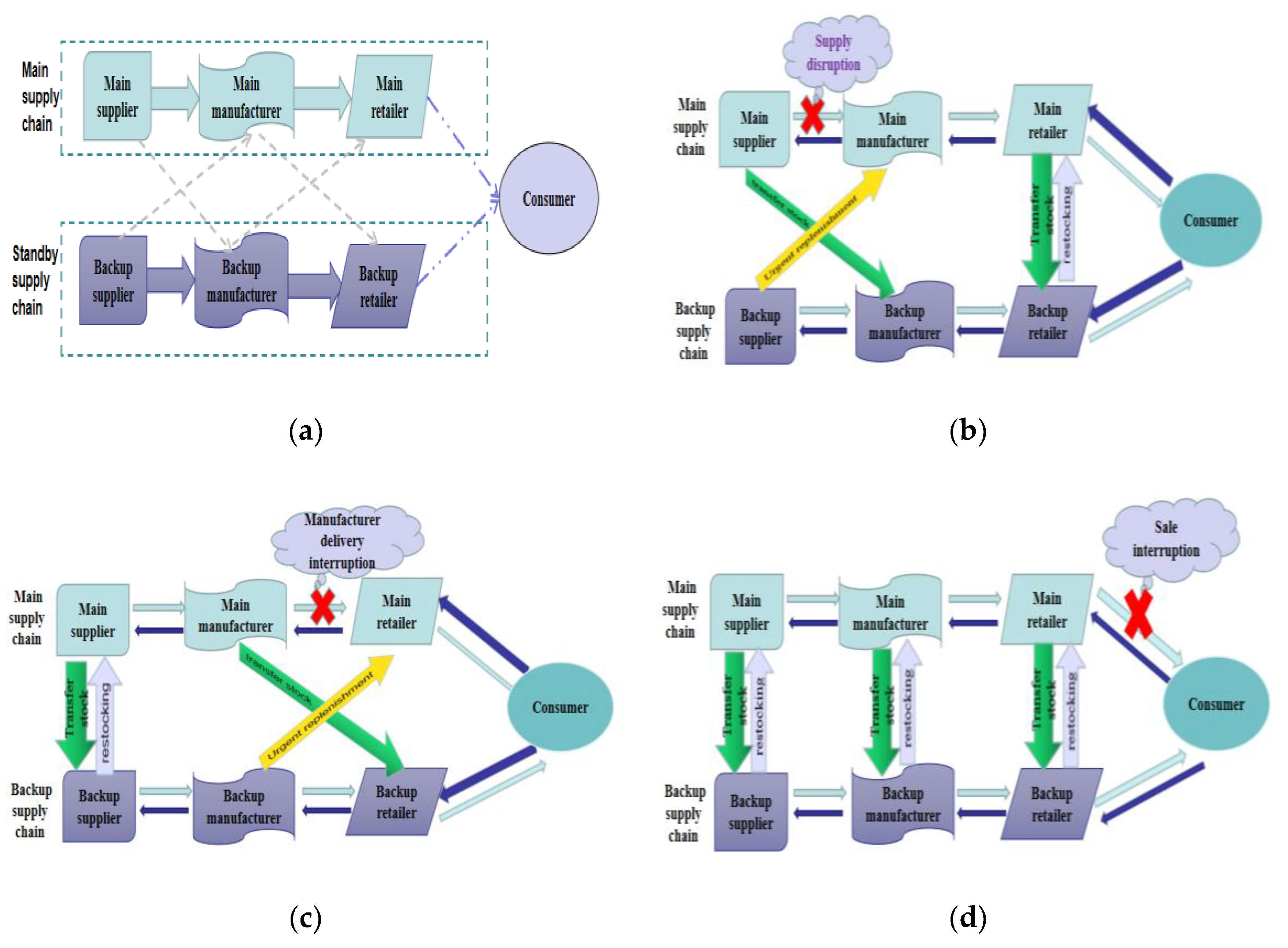
| Research Direction | Interrupt Type | Evaluation Index |
|---|---|---|
| Supply chain risk management | Supply disruption [13,19] | Order accumulation and inventory levels |
| Supply disruption [16] | Profit level | |
| Supply and demand disruptions and facility disruptions [18] | Supply capacity | |
| Supply disruption and random lead time [20] | Average cost of order delay | |
| System dynamics | Supply disruption [15] | Service level, cost, profit, and inventory level |
| Demand shocks, supply disruptions and prices [17] | Supply chain flexibility |
| Research Direction | Research Method | Advantage | Disadvantage |
|---|---|---|---|
| Supply chain disruption identification | TOPSIS and FAHP [24]; | Less quantitative data information; easy to operate; practical. | Excessive qualitative components; subjective result. |
| Supply chain disruption assessment | Fuzzy comprehensive evaluation [26]; ARI [27]; FAHP [27,30]; Bayesian Network [28]; Mathematical programming models [29]. | Simple and easy to implement; less data required. | Subjective and abstract result. |
| Supply chain disruption control | FMEA [32]; safety stock [33]; double source supply strategy [34]; fuzzy demand [35]; | Practical and applicable to various industries in different fields. | Short term risk control; poor implementation effect. |
| Supply chain risk identification, assessment, and control | System Dynamic [42,43]. | Dealing with periodic problems, complex problems, and insufficient research data. | Difficult operation; rely on a certain mathematical model. |
| Research Direction | Interrupt Type | Evaluation Index | Research Method |
|---|---|---|---|
| The research of this paper | Supply disruption, production interruption, and sales interruption | Profit level, order accumulation rate, and inventory level | System dynamics |
| Other literature studies | Supply disruption [13,15,16,19]; demand shocks, supply disruptions and prices [17]; supply and demand disruptions and facility disruptions [18]; supply disruption and random lead time [20] | Order accumulation and inventory levels [13,19]; Service level, cost, profit, and inventory level [15]; Profit level [16]; Supply chain flexibility [17]; Supply capacity [18]; Average cost of order delay [20] | TOPSIS and FAHP [24]; Fuzzy comprehensive evaluation [26]; ARI [27]; FAHP [27,30]; Bayesian Network [28]; Mathematical programming models [29]. FMEA [32]; safety stock [33]; double source supply strategy [34]; fuzzy demand [35]; System Dynamic [15,17,42,43]. |
| Number | Hypothesis |
|---|---|
| 1 | The total inventory level of the supply chain is the sum of the inventory levels of suppliers, retailers, and manufacturers; the same is true for the total order accumulation rate and total profit level of the supply chain. |
| 2 | The cumulative order rate of nodal enterprises in the supply chain is the unfulfilled order rate, that is, the difference between the order rate of downstream enterprises and the order completion rate. |
| 3 | When the interruption occurs at any node, the backup supplier’s urgent supply to the out-of-stock node enterprises will be delayed. |
| 4 | The cost of a supply chain node enterprise is composed of storage costs, ordering costs, out-of-stock penalty costs, and transportation costs. |
| Parameter | Value | Unit | Parameter | Value | Unit |
|---|---|---|---|---|---|
| Supplier inventory coverage time | 3 | week | Supplier unit storage cost | 2 | yuan |
| Supplier inventory adjustment time | 3 | week | Supplier unit transportation cost | 1 | yuan |
| Supplier delivery delay time | 1.5 | week | Manufacturer unit purchase cost | 1000 | yuan |
| Supplier initial inventory | 200 | piece | Manufacturer unit out of stock cost | 110 | yuan |
| Manufacturer inventory coverage time | 2 | week | Manufacturer unit storage cost | 5 | yuan |
| Manufacturer inventory adjustment time | 2 | week | Manufacturer unit transportation cost | 4 | yuan |
| Manufacturer receiving delay time | 1.5 | week | Retailer unit purchase cost | 1800 | yuan |
| Manufacturer initial stock | 150 | piece | Retailer unit out of stock cost | 400 | yuan |
| Retailer inventory coverage time | 1.5 | week | Retailer unit storage cost | 10 | yuan |
| Retailer inventory adjustment time | 1.5 | week | Retailer unit transportation cost | 8 | yuan |
| Retailer receiving delay time | 0.5 | week | Retailer cost of sales | 2800 | yuan |
| Retailer initial inventory | 100 | piece | Raw materials unit purchase cost | 400 | yuan |
| Supplier unit shortage cost | 20 | yuan |
| Research Contents | Interruption Time | Supply Chain Node | Interrupt Type | Evaluating Indicator |
|---|---|---|---|---|
| The research content of this paper | The fixed interruption time | Suppliers, manufacturers, retailers | Disruption of supply, production, and sales | Inventory level, order accumulation rate, and profit level |
| Dynamic change of interruption times | Suppliers, manufacturers, retailers | Disruption of supply, production, and sales | Inventory level, order accumulation rate, and profit level | |
| Existing research contents | Dynamic change of interruption times | Suppliers, manufacturers, retailers [58,59,60] | Disruption of supply, production, and sales; logistics disruption [60] | Inventory level [58,59,60], profit level [58,59] |
| The fixed interruption time | Suppliers, retailers [61] | Disruption of supply, demand, and logistics [61] | Inventory level [61] |
Publisher’s Note: MDPI stays neutral with regard to jurisdictional claims in published maps and institutional affiliations. |
© 2021 by the authors. Licensee MDPI, Basel, Switzerland. This article is an open access article distributed under the terms and conditions of the Creative Commons Attribution (CC BY) license (http://creativecommons.org/licenses/by/4.0/).
Share and Cite
Zhang, Q.; Fan, W.; Lu, J.; Wu, S.; Wang, X. Research on Dynamic Analysis and Mitigation Strategies of Supply Chains under Different Disruption Risks. Sustainability 2021, 13, 2462. https://doi.org/10.3390/su13052462
Zhang Q, Fan W, Lu J, Wu S, Wang X. Research on Dynamic Analysis and Mitigation Strategies of Supply Chains under Different Disruption Risks. Sustainability. 2021; 13(5):2462. https://doi.org/10.3390/su13052462
Chicago/Turabian StyleZhang, Qing, Weiguo Fan, Jianchang Lu, Siqian Wu, and Xuechao Wang. 2021. "Research on Dynamic Analysis and Mitigation Strategies of Supply Chains under Different Disruption Risks" Sustainability 13, no. 5: 2462. https://doi.org/10.3390/su13052462
APA StyleZhang, Q., Fan, W., Lu, J., Wu, S., & Wang, X. (2021). Research on Dynamic Analysis and Mitigation Strategies of Supply Chains under Different Disruption Risks. Sustainability, 13(5), 2462. https://doi.org/10.3390/su13052462








